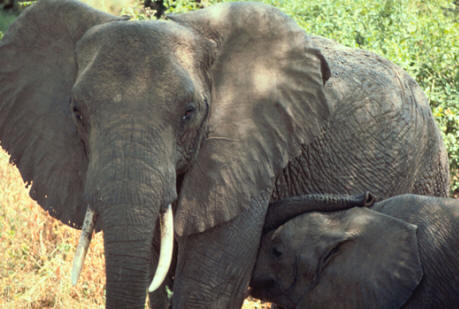Reproduction
The reproduction process of Loxodonta cyclotis has several unique characteristics. Due to the fact that this species is currently endangered, the production of offspring is crucial in the continuation of this elephant.
Female African forest elephants
reach sexual maturity around ten to twelve years of age, becoming
reproductive (Hilderbrandt et al., 2006). In contrast,
the male
elephant reaches puberty around the age of twenty-five. At this
time, the male separates from his herd. A wild male will begin
breeding around age thirty; this is when the elephant reaches a
weight and size that can compete with other males for breeding
(Perry, 1953). In addition to sexual maturity, males undergo a
periodic state of heightened sexual aggregation known as "musth."
During musth, testicular activity can increase up to four times more
than regular levels (Hilderbrandt, 2006). This causes hormonal and
behavioral changes in the elephant. Age plays a factor in this stage
for males; younger male elephants experience musth for a shorter
period of time, while the period is longer for older elephants
(Loxodonta, 2009). There are numerous behaviors that the male
exhibits while in musth. An erect walk, rubbing of the head on tree
trunks and flapping of the ears to disperse the musth scent,
low-pitched calls, and slow urination are all behaviors that
attracts females, letting them know that the male is in musth and is
ready to mate (Loxodonta, 2009).
Mating usually occurs during the dry
season, mostly in the months of  January and February (Perry, 1953).
Larger, more dominant, males are generally preferred by the female
elephants, so males must compete with one another to find a partner
(Loxodonta, 2009). Elephants have the longest gestation period,
or the process of the young being carried in the womb between
conception and birth, being twenty to twenty-two months
(Hilderbrandt, 2008). It is average for a female to only give birth
to one offspring at a time (having twins is very rare). She will
conceive every three to six years, having a total of seven offspring
on average during her lifespan (African, 2013). Mothers, along with
other female members of the herd, care for the young until roughly
age eight. At this point, the calf becomes independant (Loxodonta,
2009).
January and February (Perry, 1953).
Larger, more dominant, males are generally preferred by the female
elephants, so males must compete with one another to find a partner
(Loxodonta, 2009). Elephants have the longest gestation period,
or the process of the young being carried in the womb between
conception and birth, being twenty to twenty-two months
(Hilderbrandt, 2008). It is average for a female to only give birth
to one offspring at a time (having twins is very rare). She will
conceive every three to six years, having a total of seven offspring
on average during her lifespan (African, 2013). Mothers, along with
other female members of the herd, care for the young until roughly
age eight. At this point, the calf becomes independant (Loxodonta,
2009).